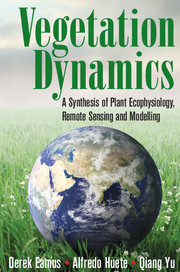Book contents
- Frontmatter
- Contents
- Preface
- Section One Plant Ecophysiology
- Section Two Remote Sensing
- Section Three Modelling
- Section Four Case Studies
- 14 Boreal Forests
- 15 Arid and Semi-Arid Grasslands
- 16 Savannas
- 17 Seasonal Behaviour of Vegetation of the Amazon Basin
- 18 Tropical Montane Cloud and Rainforests
- 19 Groundwater Dependent Ecosystems
- 20 Global-Change Drought and Forest Mortality
- Index
- References
14 - Boreal Forests
from Section Four - Case Studies
Published online by Cambridge University Press: 05 June 2016
- Frontmatter
- Contents
- Preface
- Section One Plant Ecophysiology
- Section Two Remote Sensing
- Section Three Modelling
- Section Four Case Studies
- 14 Boreal Forests
- 15 Arid and Semi-Arid Grasslands
- 16 Savannas
- 17 Seasonal Behaviour of Vegetation of the Amazon Basin
- 18 Tropical Montane Cloud and Rainforests
- 19 Groundwater Dependent Ecosystems
- 20 Global-Change Drought and Forest Mortality
- Index
- References
Summary
Introduction
Boreal (meaning northern) forests occupy a circumpolar belt (Fig. 14.1) in the northern hemisphere. They are mostly dominated by evergreen needle-leaved species, including pines (Pinus), spruce (Picea), and fir (Abies), but also the deciduous conifer larch (Larix), and cover about 17 percent of the earth's land surface. They are a dominant land cover in Russia, Canada and northern Europe. In Russia boreal forests are called Taiga.
An example of maximum, minimum, and mean temperatures, day length, and total precipitation (rainfall plus snowfall) for a Canadian boreal forest is given in Figure 14.2. Because boreal forests are found in high latitudes, winter temperatures are very low, summer temperatures are low-to-moderate, snowfall occurs every year, and day length varies substantially between seasons (Fig. 14.2). The growing season is confined to late spring, summer, and early autumn (100–200 days long). Where high elevation mountain ridges extend south from high latitude regions, boreal forest can also extend south–for example in New Jersey and the Appalachians in the United States. Boreal forests store approximately double the amount of carbon found in rainforests.
Coping with Freezing Winters: Photosynthetic C Gain and Transpiration
Consideration of the fluxes of C and water in boreal forests requires an understanding of how evergreen trees tolerate the stresses associated with very low winter temperatures. There are three major stresses that evergreen trees in boreal forests need to tolerate. The first is freezing temperatures and this stress induces two additional stresses: water stress and photo-inhibition.
When air and soil temperatures are sub-zero for prolonged periods, the potential for the formation of ice within cells is high. When water freezes it expands and this ruptures living cells and xylem. When the ice melts, the ruptured cell is dead (and the xylem is dysfunctional). Therefore intra-cellular freezing must be avoided in boreal trees. As autumnal temperatures decline and day length shortens, evergreen trees undergo a process of hardening whereby the temperature that can induce freezing damage progressively declines (that is, frost hardiness increases). Accumulation of solutes within cells depresses the freezing point of intra-cellular water by several degrees but this is insufficient protection; more important are the poorly understood biochemical changes that prevent intra-cellular ice nucleation. By preventing ice nucleation cells can tolerate temperatures as low as −38°C, which is the spontaneous nucleation temperature of water.
- Type
- Chapter
- Information
- Vegetation DynamicsA Synthesis of Plant Ecophysiology, Remote Sensing and Modelling, pp. 347 - 367Publisher: Cambridge University PressPrint publication year: 2016



